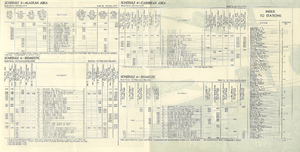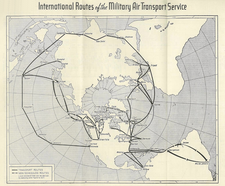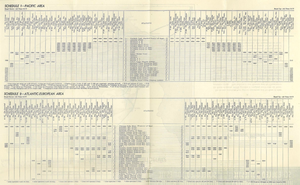Military Air Transport Service
This article includes a list of generalreferences,butit lacks sufficient correspondinginline citations.(January 2013) |
| Military Air Transport Service | |
|---|---|
 Military Air Transport Service emblem | |
| Active | 1948–1966 |
| Country | |
| Branch | Department of DefenseUnified Command |
| Type | Major Command |
| Role | Strategic Airlift |
| Aircraft flown | |
| Transport | C-141A Starlifter C-130 Hercules C-135 Stratolifter] C-133 Cargomaster C-124 Globemaster C-121 Super Constellation C-54 Skymaster C-47 Skytrain RC-130 Hercules |
TheMilitary Air Transport Service(MATS) is an inactiveDepartment of DefenseUnified Command. Activated on 1 June 1948, MATS was a consolidation of theUnited States Navy'sNaval Air Transport Service(NATS) and theUnited States Air Force'sAir Transport Command(ATC) into a single joint command. It was inactivated and discontinued on 8 January 1966, superseded by the Air Force'sMilitary Airlift Command(MAC) as a separate strategic airlift command, and it returned shore-based Navy cargo aircraft to Navy control as operational support airlift (OSA) aircraft.
In 1966, theWorld War IIAir Transport Command(ATC) (1942–1948) and the Military Air Transport Service were consolidated withMilitary Airlift Command(MAC) (1966–1992).
Overview
[edit]The Military Air Transport Service (MATS) was activated under United States Air ForceMajor GeneralLaurence S. Kuter,in order to harness interservice efforts more efficiently. It was an amalgamation of Navy and Army air transport commands, jointly placed by the Department of Defense under the control of the newly created United States Air Force (USAF) as a unified (joint) command.
During the Second World War, the Army Air Force's aerial transportat arm was theAir Transport Command,which had a dual function of ferrying new aircraft from factories to combat theaters and transportation of troops and supplies, also organized by Tunner. TheNaval Air Transport Servicefocused on supporting deployed Naval and Marine personnel transporting vital cargo, specialist personnel and mail to the Fleet and ground forces, especially in advanced areas of operation.
MATS was the first Joint-Service command, and naval aircrews participated in every major MATS airlift operation. MATS would organizationally be under the Department of the Air Force, as the vast majority of its equipment and personnel of ATC had been inherited by the Air Force with the inactivation of the USAAF.
During theBerlin Airlift,Naval aviators flew transport aircraft from the United States to European supply depots; in theKorean War,MATS Navy Squadrons airlifted some 17,000 battle casualties. In its original organization, aRear Admiralcommanded the MATS Pacific Division and another rear admiral served as MATS vice-commander. During the 1958 reorganization, senior Naval officers were on the staffs of the commanders of both EASTAF and WESTAF, and at MATS Headquarters.
In 1965 conflicting views of the Air Force and Navy triggered by the demands of theVietnam Warled to the services returning to separate airlift commands. In turn, MATS was disbanded and superseded in the Air Force by theMilitary Airlift Command,during a 1966 restructuring.
History
[edit]Origins
[edit]With the end of World War II, theUnited States Army Air ForcesAir Transport Commandfound itself in limbo. Senior USAAF authorities considered ATC to be a wartime necessity that was no longer needed, and expected its civilian personnel, including former airline pilots, to return to their peacetime occupations. Senior ATC officers, on the other hand, thought that ATC should be developed into a national government operated airline, an idea that was soundly opposed by the airline industry. While the war had firmly established the necessity of a troop carrier mission, most military officers believed the role performed by ATC should be provided by contract carriers.
When the United States Air Force was established as a separate service in 1947, the Air Transport Command was not established as one of its major commands. The ATC commander and his staff took it upon themselves to convince the new civilian leadership of the newly created Department of Defense (DOD) (and Secretaries of the Army and Air Force) that ATC had a mission. They seized upon testimony by formerI Troop Carrier Commandcommander Major GeneralPaul L. Williamsthat the Air Force should have a long-range troop deployment capability, and began advocating that ATC transports could be used to deploy troops. Williams had been pressing for the development of a long-range troop carrier airplane when he made his statement.

The DOD believed it should have its own air transport service and decided that ATC should become theMilitary Air Transport Service(MATS), supported by the Air Force, even though not listed as a formal military mission. Also, as a cost-saving measure, MATS would combine the resources of Air Transport Command with those of theNaval Air Transport Service.This way the command would be sanctioned by the Department of Defense, and not by either the Air Force or the Navy.
Although MATS was under the operational control of the United States Air Force, the United States Navy was a full partner in the command and operational components of the organization. Major naval components of MATS were naval air transport (VR) squadrons. VR-3[1]and VR-6[2]were assigned to McGuire AFB and VR-22 was assigned to the Naval Air Transport Station atNaval Station Norfolk/Chambers Field, Virginia. Together they constituted MATS EASTAF's Naval Air Transport Wing, Atlantic. On the Pacific Coast, Naval Air Transport Wing, Pacific, consisted of Air Transport Squadron VR-7 and Maintenance Squadron VR-8, both atNaval Air Station Moffett Field,California. A detachment of VR-7 was also stationed atTachikawa Air Base,Japan.
Naval aviators flew scheduled MATS routes toNewfoundland,Iceland,Scotland,West Germany,Italy,Puerto Ricoand Africa. In the Pacific, MATS naval aviators flew to all MATS stations fromHawaiito Japan toSouth Vietnam,Bangkok,India and toSaudi Arabia.
Air Force pilots flew Navy MATS planes, just as naval aviators could be found piloting Air Force MATS transport aircraft.
Organization
[edit]



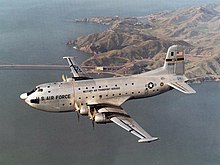



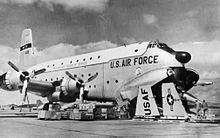
During World War II, the USAAFAir Transport Commandprovided worldwide transport service to every continent on the globe. Inheriting that legacy, MATS continued that service and organized it into three major transport divisions;
- Atlantic Division (after 1 July 1958: EASTAF) - FromMcGuire AFB,New Jersey, provided service across the Atlantic Ocean to Europe; to the Caribbean and South America; to North Africa and the Middle East toDhahran,Saudi Arabia
- Pacific Division (after 1 July 1958: WESTAF) - FromTravis AFB,California, provided service to Hawaii and on to locations in the Pacific, includingJapanand thePhilippines;across Southeast Asia;India;Pakistanand on toDhahran,Saudi Arabia.
- Continental Division - From McGuire to points in Northern Canada; along the North Atlantic coast north toThule AB,Greenland. From Travis north toMcChord AFB,Washington, then north toAlaskaandAleutian Islands,then a connection intoTachikawa AB,Japan fromShemya AFS.Also provided coast to coast aeromedical evacuation flights within the United States and cargo service between major Air ForceAir Materiel Commanddepots. The division was disbanded on 1 July 1958, with mission divided between Eastern Transport Air Force (EASTAF) and Western Transport Air Force (WESTAF).
When MATS was established, it also took responsibility for several other missions:
- Special Air Mission(SAM)
The Special Air Mission was the transport of thePresident of the United States;Vice-President;Cabinet Members;Member of Congress;Senators,and designated other individuals, such as ForeignHeads of State.
- Air Rescue Service(ARS)
Provided rescue of downed military service members in enemy occupied areas; humanitarian relief to civilians in emergency conditions (floods, hurricanes, earthquakes)
- Air Weather Service(AWS)
Weather forecasting for military airfields; hurricane hunters.
Mapping the world providing accurate aerial charts to military aviators wherever they need to be. Also producing all Air Force training films; public relations films; monthly newsreels, and coordinating with private filmmakers with regards to use of Air Force equipment and facilities.
Evacuation of wounded military personnel from combat zones; transport of critically ill military personnel (and dependents) to military medical facilities for treatment.
Performed unconventional warfare missions during theKorean Warand early years of theCold War(1950–1956).
Major operations
[edit]Berlin Airlift (1948–1949)
[edit]MATS was established on 1 June 1948, less than a month before the commencement of theBerlin Airlift-- "OPERATION VITTLES" where at peak operations, planes were landing and departing every ninety seconds or so shuttling in thousands of tons of supplies, food, and fuel each day - but they were not MATS airplanes. The Soviet Union had blocked all surface transportation in the western part of Berlin. Railroads tracks were destroyed, barges were stopped on the rivers, and highways and roads blocked. The only avenue left was through the air. On 26 June 1948, the airlift began. Troop carrier transports from around the globe began making their way to Germany, where they were assigned to United States Air Forces, Europe. Squadrons transferred from as far away asHawaiiand Japan, and included two of the U.S. Navy's air transport squadrons assigned to MATS. MATS itself was not "in charge" of the airlift, although several MATS staff officers were sent to Germany to serve in the Airlift Task Force in an administrative role. Lt. GeneralWilliam H. Tunnerwas placed in overall command of airlift operations, reporting to the commander of United States Air Forces, Europe. The airlift itself was a USAFE operation and all airplanes assigned to it were assigned to one of five troop carrier groups that were sent to Europe to operate the airlift. MATS played a supporting role, including ferrying C-54s to and from the airlift bases and maintenance depots in the United States and the MATS C-54 training school trained pilots for temporary duty in the airlift. MATS transports delivered crucial aircraft parts to the airlift bases in Europe. This operation would continue for some 15 months until the Soviets lifted the blockade. MATS would provide numerous humanitarian airlifts of global proportions. The U.S. Navy was an integral part of MATS, providing five transport squadrons to the joint service effort, but they operated under USAFE while they were part of the airlift.
Korean War (1950–1953)
[edit]The organization's next major test was the bootstrap supply operations supporting theUnited Nationstroops under GeneralDouglas MacArthurin the country ofSouth Koreawhich was nearly overrun by the time UN forces were mobilized. The MATS role was purely logistical, and operated from the United States to Japan. Theater transport forces assigned to the Far East Air Forces Combat Cargo Command, which became the315th Air Division,operated supply routes into Japan and provided troop carrier services for UN forces.
Suez, Lebanon and Taiwan Straits Crisis (1956–1958)
[edit]During the 1956Suez Crisis,MATS MATS airlifted 1,300 Colombian and Indian troops fromBogotáandAgrato the United Nations staging area inNaples,Italy, to supplement the UN police force in the Suez area. In 1958, MATS airlifted 5,500 tons of cargo and 5,400 troops to the Middle East in support of the Lebanese government, also supporting the move of a TAC Composite Air Strike Force to the area. Also in 1958, MATS flew 144 airlift trips to the Far East when the crisis arose in theFormosa Straits,supporting the move of a Composite Air Strike Force, and airlifting a squadron ofF-104 StarfighterstoTaiwan.
Operation Deep Freeze (1957–1963)
[edit]In December 1962, MATS DouglasC-124 Globemastersended six years of seasonal flying as members of the Air Force-Navy team resupplying scientific stations in theAntarctic.During that time the aircraft, operated by the63d Troop Carrier Wingstationed atDonaldson Air Force Base,South Carolina, air-dropped about 4,000 tons of supplies from the main Antarctic base atMcMurdo Soundto remote stations near and at the South Pole. Beginning in 1963, LockheedC-130E Hercules,newer, faster, and longer range, picked up the MATS portion of the mission. The performance of the C-124s in the Antarctic cold strengthened the concept of airlift flexibility by doing in a few weeks (each year) a job that would have taken surface transportation several months. During Deep Freeze III, a C-124 air-dropped a seven-ton tractor to an isolated site, and during Deep Freeze 62 (October–December 1961), three C-124's made the longest flight in Antarctic history, a 3,100-mile round trip to airdrop supplies. Also during Deep Freeze 62, Lt. Gen.Joe W. Kellybecame the first MATS commander to visit the operation. MATS vice commander, Maj. Gen.Raymond J. Reeves,visited Deep Freeze 63.
Congo Airlift (1960–1963)
[edit]MATSC-124 GlobemastersandC-118 Liftmasters(and in November 1962, pure-jetC-135 Stratolifters) by the end of November had chalked up more than 2,000 missions in history's longest airlift reaching 5,000 miles from Europe around Africa's West Coast toLeopoldvillein theCongo.MATS entered theUnited Nationsairlift under direction of theUnited States Air Forces in Europe(USAFE)322d Air Division,16 July 1960, and at the peak had 60 aircraft committed. By the end of 1962, about 49,000 troops and 11,000 tons of cargo had been airlifted to and from points as far away asNew Delhi,India.
Berlin Crisis (1961)
[edit]As a result of the construction of the Berlin Wall and the ending of free crossing to and from their occupation zone of Berlin, more than 100 MATS =aircraft from EASTAF and WESTAF participated in deployments of American forces from the United States toWest Germanyand France.
When the Reserve Forces were called to active duty in October 1961, MATS airlift force and technical units provided support for their movement to Europe. Operation Stair Step was the name given to the deployment ofAir National Guardfighter units overseas to NATO bases in France, and Operation High Top was the redeployment, June–August 1962. In High Top, for example, more than 260 missions were flown by MATS aircraft of all types, including the C-97's which themselves had been called to active duty. These aircraft returned more than 9,600 ANG personnel and 1,400 tons of equipment.
On addition, the 101st Airborne Division was airlifted from Fort Campbell, Kentucky to locations in Turkey. Approximately 2,000 personnel and 900 tons of equipment were airlifted (Exercise Checkmate II). During the exercise, about 300 MATS airmen and officers lived in tents for about three weeks handling maintenance and communications. Lt. Gen. Joe W. Kelly, MATS commander, was on hand to greet the first arriving aircraft, Despite "miserable" weather, no accidents or incidents occurred.
Throughout 1962, tensions were high in Europe and in January, Exercise Long Thrust II was commenced in which MATS new four-engined jets, the BoeingC-135 Stratolifter,made their first appearance in a major airlift when 12 of them airlifted nearly 500 Army troops over the north polar route fromFort Lewis,Washington, to centralWest Germany.They made the nonstop trip in little more than 10 hours compared to the piston-engined aircraft which averaged between 30 and 35 hours along normal routes. Altogether, more than 200 MATS aircraft moved 5,300 troops of three battle groups of the Army's4th Infantry Divisionin the deployment phase. The jets brought one battle group back. In West Germany, the troops participated in ground maneuvers with NATO forces.
Cuban Missile Crisis (1962)
[edit]In the midst of one of the heaviest airlift schedules it has ever had (more than 17 airlifts under way or developing during October and November), MATS was called on to support the buildup of forces in the southeastern part of the United States. On 16 October, MATS began working at its wartime activity rate. Between 16 October and the end of the month, MATS airlifted thousands of troops and thousands of tons in hundreds of sorties from bases throughout the country intoFloridaandGuantánamo Bay,Cuba.Included in this was the first major airlift ofUnited States Marinesand their combat gear by MATS. Also, during this buildup, MATS lost its firstC-135 Stratolifterjet while it was engaged in an ammunition airlift to Guantánamo Bay. All three of the technical services stepped up activities to provide close weather, rescue, and documentation support to the buildup.
During the airlift operation, MATS was called on to react to a call for arms to India in early November to stem theCommunist Chineseinvasion. The airlift required the movement of 980 tons of small arms more than 6,000 miles fromRhein-Main AB,West Germany,toDum-Dum Airport,Calcutta.This "no notice" airlift was accomplished in eight days by MATSC-135 Stratolifterjets.
Operation "Big Lift" (1963)
[edit]In the first time that a fullUnited States Armydivision and elements of aTactical Air CommandStrike Force were ferried across the ocean in one big airlift, 15,358 officers and men of the2nd Armored Division,their support troops, and 504 tons of battle equipment were airlifted by 204 MATS aircraft from eight bases in the South and southwestern United States to France and Germany. They were accompanied by 116 tactical fighters and reconnaissance aircraft of the Composite Air Strike Force (CASF) who flew across the Atlantic. The entire operation was accomplished in 2½ days, employing 234 missions. TheC-135 Stratolifterjets made the 5,600-mile trip in 10½ hours nonstop, carrying 75 troops each. It took theC-124 Globemastersthree times as long, with refueling stops inBermudaand theAzoresto carry 80 troops and cargo. Following theNATOground manoeuvers in Europe, the troops were lifted back to the United States on 21 November 1963
Vietnam War
[edit]Beginning in 1948, MATS flew airlift missions intoFrench Indochina,providing airlifts of military equipment and supplies to the French government and colonial Vietnamese forces fighting theViet Minh.In 1954, at the request of the French, woundedLegionnairesfromDien Bien Phuwere transported fromTan Son Nhut Airportto eitherAlgeriaor France. Initially flown fromSaigontoTachikawa ABnear Tokyo onC-124s,over 14,000 wounded soldiers received stabilization medical care. From Japan, the wounded were airlifted across the Pacific Ocean to the Western United States on MATSC-97s.At each of the subsequent stops atHickam AFB,Hawaii;Travis AFB,California, andWestover AFB,Massachusetts, there were layovers of about a day. This portion of the journey was carried out by MATS' Pacific Division. From Westover, the Atlantic Division took charge and airlifted the wounded toOrly Air Basein France andOran AirportinAlgeria.From start to finish, the mission took about a month to complete.
Throughout the 1950s and early 1960s military aid was shipped to theSouth Vietnamesegovernment by MATS airlift flights into Tan Son Nhut. In addition, military flights were made toDon Muang AirportinBangkokwhich were designated for the Thai Militarily to protect their border along theMekong River,or clandestinely to the Laotian Government, who were fighting communist rebels inLaos.
As the United States built up its forces in Southeast Asia in the early 1960s, the number of MATS flights to the area increased. MATS C-124s andC-133 Cargomasterswere common sights. After the 1964Gulf of Tonkin Incident,and the decision being made to escalate United States involvement in the Vietnam War, MATS performed a critical role in the air transport of personnel and equipment to the war zone. Throughout 1964 and 1965 MATS flew large numbers of United States Army and United States Marines to South Vietnam. Large MATS aerial ports were established atDa Nang,Cam Ranh BayandTan Son Nhutin South Vietnam, as well as atDon Muang Airportin Thailand to support the United States forces there. The first large-scale MATS jet transport flights ofC-141A Starlifterswere toTan Son Nhut Air Basein 1965.
During Vietnam, MATS was jokingly said to be an acronym for "Maybe Again, Tomorrow, Sometime."[3]
Military Airlift Command
[edit]On 1 January 1966, as a result of the Navy announcing the withdrawal of its components, MATS was redesignatedMilitary Airlift Command.
The R5D Skymasters of Naval Transport Squadron Seven Alpha (VR-7A) were retired in July 1966 and the unit inactivated. VR-7, flying C-121/RV-7 Super Constellations remained attached to MAC until 31 January 1967, and the Naval Air Transport Wing (Pacific) was inactivated on 23 March 1967. VR-8 and VR-22 at NAS Moffett Field withdrew its C-130s from MAC on 20 April. The last naval squadron, VR-3, flying C-130s from McGuire AFB, was inactivated on 30 June and the formal DOD program action directive relieving the Navy from MAC responsibilities became effective 1 July 1967.
Most passenger transport missions except the Special Air Mission were contracted out by MAC to commercial airlines such asPan American,TWA,United,Continental,Northwestand charter companies such asFlying Tiger,using the Civil Reserve Air Fleet (CRAF). This provided commercial airline pilots and aircrews valuable training, and during the years of theVietnam War,seeingBoeing 707andDouglas DC-8commercial airliners at MAC aerial ports in Southeast Asia was a common sight.
On 1 December 1974, MAC expanded its mission by acquiring the theater troop carrying and tactical airlift mission (i.e.,C-130 Hercules,C-123 Provider,C-7 Caribou) previously performed by the combat commands (TAC, PACAF, USAFE). In 1987, MAC was designated as the Air Force component of theUnited States Transportation Command(USTRANSCOM), a unified joint-service command.
In June 1992, MAC was reorganized and redesignated as theAir Mobility Command(AMC) with a broadened mission of aerial refueling (i.e.,KC-135 StratotankerandKC-10 Extender), acquired from the inactivatingStrategic Air Command.AMC then succeeded MAC as the USAF component of USTRANSCOM.
Lineage
[edit]- Established and activated asMilitary Air Transport Serviceon 1 June 1948
- Mission and operational control ofAir Transport Command,established on 29 May 1941, consolidated into organization same date.
- Air Transport command discontinued and inactivated same date.
- Mission and operational control ofNaval Air Transport Service,established on 12 December 1941, consolidated into organization same date.
- Naval Air Transport Service disestablished, 1 July 1948
- RedesignatedMilitary Airlift Commandon 1 January 1966
- Navy components assigned to: United States Navy.
Components
[edit]Headquarters
[edit]- Headquarters, MATS
- Andrews AFB,Maryland, 1 June 1948
- Scott AFB,Illinois, 15 January 1958 – 1 January 1966
- Continental Division,1 June 1948
- Headquartered:Kelly AFB,Texas
- Redesignated:Western Transport Air Force,(WESTAF) 1 July 1958 – 1 January 1966
- Headquarters moved to:Travis AFB,California
- Atlantic Division,1 June 1948
- Headquartered:Westover AFB,Massachusetts
- Redesignated:Eastern Transport Air Force,(EASTAF) 1 July 1958 – 1 January 1966
- Headquarters moved to:McGuire AFB,New Jersey
- Pacific Division, 1 June 1948 – 30 June 1958
- Headquarters:Hickam AFB,Territory of Hawaii
- Inactivated, units reassigned to WESTAF
Services
[edit]- Air Rescue Service(ARS)
- Redesignated: Aerospace Rescue Recovery Service (ARRS)
- Air Weather Service(AWS)
- Special Airlift Mission(SAM)
- Air Photographic and Charting Service(APCS)
- Aeromedical Transport Wing(AMTW)
- Air Resupply And Communications Service(ARCS)
Air Transport Units
[edit]- 1100th Special Air Missions Wing,Bolling AFB,District of Columbia, 1 June 1948
- Redesignated:1254th Air Transport Wing,Andrews AFB,Maryland, 10 July 1961 – 8 January 1966
- Personnel and equipment reassigned to:89th Military Airlift Wing,Military Airlift Command, 8 January 1966
- 1405th Aeromedical Transport Wing,Scott AFB,Illinois, 26 August 1948
- Redesignated: 375th Aeromedical Airlift Wing, 31 December 1965
- Transferred to Military Airlift Command, 8 January 1966
- 1501st Air Transport Wing,Fairfield-Suisun (Later Travis) AFB,California, 1 June 1948 – 8 January 1966
- Personnel and equipment reassigned to:60th Military Airlift Wing,Military Airlift Command, 8 January 1966
- 1500th Air Transport Wing,Hickam AFB,Hawaii, 1 June 1948
- Redesignated:1502d Air Transport Wing,1 July 1955 – 8 January 1966
- Personnel and equipment reassigned to:61st Military Airlift Wing,Military Airlift Command, 8 January 1966
- 1503d Air Transport Group,Tachikawa AB,Japan, 1 June 1948
- Redesignated:1503d Air Transport Group,22 June 1964 – 8 January 1966
- 1600th Air Transport Group,Westover AFB,Massachusetts, 1 June 1948 – 1 April 1955
- 1602d Air Transport Wing,Wiesbaden AB,Germany (later West Germany), 1 June 1948 – 1 July 1952
- Transferred toKindley AFB,Bermuda, Bermuda Base Command
- 1603d Air Transport Wing,Wheelus AB,Libya, 1 June 1948 – 1 January 1953
- Reassigned toUnited States Air Forces in Europe
- 1605th Air Transport Wing,Lajes AB,Azores, 1 June 1948 – 8 January 1966
- 1607th Air Transport Group,Dover AFB,Delaware, 1 January 1954
- Redesignated:1607th Air Transport Wing,1 February 1954 – 8 January 1966
- Personnel and equipment reassigned to:436th Military Airlift Wing,Military Airlift Command, 8 January 1966
- 1608th Air Transport Group,Charleston AFB,South Carolina, 15 January 1954
- Redesignated:1608th Air Transport Wing,1 March 1955 – 8 January 1966
- Personnel and equipment reassigned to:437th Military Airlift Wing,Military Airlift Command, 8 January 1966
- 1611th Air Transport Wing,McGuire AFB,New Jersey, 1 May 1954 – 8 January 1966
- Personnel and equipment reassigned to:438th Military Airlift Wing,Military Airlift Command, 8 January 1966
- 1700th Air Transport Group,Kelly AFB,Texas, 1 June 1948 – 1 May 1957
- 1701st Air Transport Wing,Great Falls AFB,Montana, 1 June 1948 – 1 May 1953
- Reassigned to:Brookley AFB,Alabama, 1 May 1953 – 18 June 1957
- 1703d Air Transport Group,Brookley AFB,Alabama, 1 October 1948 – 18 June 1957
- 1705th Air Transport Group,McChord AFB,Washington, 1 August 1950
- Reassigned to: North Pacific Air Transport Wing, (Provisional), 1 October 1951 – 1 January 1952
- Reassigned to:1705th Air Transport Group,1 January 1952 – 18 June 1960
- Personnel and equipment reassigned to:62d Troop Carrier Wing,18 June 1960
- Redesignated: 62d Air Transport Wing, 1 January 1965
- Redesignated: 62d Military Airlift Wing, Military Airlift Command, 8 January 1966
- 1707th Air Transport Wing,Palm Beach AFB,Florida, 1 September 1951
- Reassigned to:Tinker AFB,Oklahoma, 1 July 1959 – 8 January 1966
- Personnel and equipment reassigned to:443d Military Airlift Wing,Military Airlift Command, 8 January 1966
Note: 4-digit Military Air Transport Service units at all levels were considered Major Command (MAJCOM) provisional units by the USAF due to MATS being a Department of Defense Unified Command. Under the USAF lineage system they did not a permanent lineage or history and were discontinued upon inactivation.
Troop Carrier Units
[edit]On 1 July 1957 a reorganization of USAF troop carrier forces included the transfer ofTactical Air CommandEighteenth Air Forceheavy-liftC-124 Globemaster IIunits to MATS. However, the units retained their troop carrier designation and remained dedicated to support TAC on worldwide troop deployments.
- 62d Troop Carrier Group,Larson AFB,Washington, 1 July 1957 – 18 June 1960
- 62d Troop Carrier Wing,McChord AFB,Washington, 18 June 1960
- Redesignated: 62d Air Transport Wing, Heavy, on 1 January 1965
- Redesignated:62d Military Airlift Wing,Military Airlift Command, 8 January 1966
- 61st Troop Carrier Group,Donaldson AFB,South Carolina, 1 July 1957 – 8 October 1959
- 63d Troop Carrier Group,Donaldson AFB,South Carolina, 1 July 1957 – 18 January 1963
- 63d Troop Carrier Wing,Hunter AFB,Georgia, 18 January 1963 – 8 January 1966
- Redesignated:63d Military Airlift Wing,Military Airlift Command, 8 January 1966
Station facilities
[edit]Upon its establishment, Military Air Transport Service inherited much of Air Transport Command's worldwide network of stations and transport routes. By the time of its disestablishment, MATS had closed its facilities at many of these stations; however, some are still in use today byAir Mobility Commandin support of United States interests around the world.
- United States
- Biggs AFB,Texas
- Griffiss AFB,New York
- Hill AFB,Utah
- Langley AFB,Virginia
- March AFB,California
- McClellan AFB,California
- Mitchel AFB,New York
- Muroc (Edwards) AFB,California
- NAS Alameda,California
- NAS Corpus Christi,Texas
- NAS Norfolk,Virginia
- NAS Oakland,California
- NAS Jacksonville,Florida
- NAS Patuxent River,Maryland
- NAS San Diego,California
- National Airport,Washington, D.C.
- NOTS China Lake,California
- Olmsted AFB,Pennsylvania
- Robins AFB,Georgia
- NAS Saufley Field,Florida
- Tinker AFB,Oklahoma
- Wright-Patterson AFB,Ohio
|
|
Major aircraft assigned
[edit]
|
|
Accidents and incidents
[edit]- On 22 March 1955, a U.S. NavyDouglas R6D-1 Liftmaster,BuNo 131612, operating a MATS flight fromTokyo,Japan,toTravis Air Force Base,California,viaHickam Air Force Base,Territory of Hawaii,flew into a mountain peakin Hawaii, killing all 66 people – 55 military passengers, two civilian passengers, and a Navy crew of nine – on board. It remains both the deadliest aviation accident in the history of Hawaii and the worstheavier-than-airaccident in the history of U.S.naval aviation.[4][5][6][7]
- On 10 October 1956, a U.S. Navy Douglas R6D-1 Liftmaster, BuNo 131588, operating a MATS flight fromRAF Lakenheath,England,toLajes Fieldin theAzoresdisappearedover theAtlantic Ocean,killing all 59 people – 50 U.S. Air Force passengers from the305th Bombardment Wingand a Navy crew of nine – on board. A search discovered wreckage from the aircraft floating in the Atlantic, but no survivors or bodies ever were found.[8][9][10]
References
[edit]![]() This article incorporatespublic domain materialfrom theAir Force Historical Research Agency
This article incorporatespublic domain materialfrom theAir Force Historical Research Agency
- ^"VR-3".Navy MATS VRs.
- ^"VR-6".Navy MATS VRs.Retrieved2 December2016.
- ^Broughton, Jack,Thud Ridge.New York: Bantam Books, 1969.
- ^Aviation Safety Network Aircraft Accident Douglas R6D-1 (DC-6) 131612 Honolulu, HI
- ^Associated Press, "66 Killed as Navy Plane Hits Hawaiian Peak,"St. Louis Post-Dispatch,story dated 22 March 1955, quoted in full atlifegrid.com Charles J. Coombs, Jr.Archived30 December 2013 at theWayback Machine
- ^"Chronology of Significant Events in Naval Aviation:" Naval Air Transport "1941 -- 1999".Archived fromthe originalon 31 March 2016.Retrieved4 January2013.
- ^Grossnick, Roy A.,United States Naval Aviation 1910-1995,Washington, D.C.: Naval Historical Center, undatedArchived12 September 2012 at theWayback MachineISBN0-945274-34-3,p. 206.
- ^Aviation Safety Network Aircraft Accident Douglas R6D-1 (DC-6) 131588 Land’s End, UK
- ^"Chronology of Significant Events in Naval Aviation:" Naval Air Transport "1941 -- 1999".Archived fromthe originalon 31 March 2016.Retrieved4 January2013.
- ^Grossnick, Roy A.,United States Naval Aviation 1910-1995,Washington, D.C.: Naval Historical Center, undatedArchived12 September 2012 at theWayback MachineISBN0-945274-34-3,p. 214, states that the accident date was 11 October 1956.
- Stanley M. Ulanoff,MATS: The Story of the Military Air Transport Service,1964, The Moffa Press, Inc.
- Office of Air Force History,The United States Army Air Forces in World War II,edited by Craven and Cate
- James Lee,Operation Lifeline - History and Development of the Naval Air Transport Service,1947, Ziff-Davis Publishing Company
- Nicholas M. Williams,Aircraft of the Military Air Transport Service, 1948–1966,1999, Midland.'


